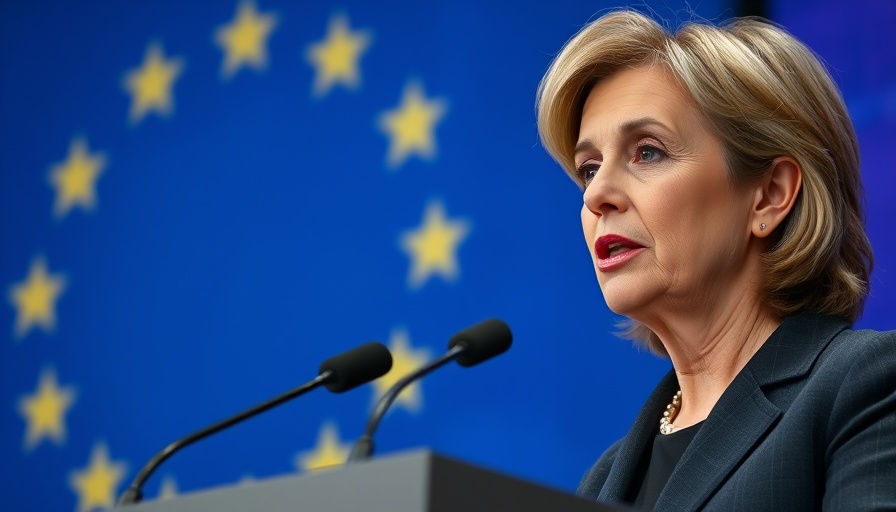
Unraveling the Trade Tensions: An Overview
The recent escalation in trade tensions between the United States and its closest allies, notably the European Union (EU) and Canada, marks a significant turn in international trade relations. On April 1, a series of retaliatory tariffs initiated by the EU went into effect in direct response to President Donald Trump's imposition of a 25% tariff on steel and aluminum imports. This moment represents more than just a financial maneuver; it encapsulates the profound impact that trade policies can have on geopolitical dynamics and economic stability.
EU and Canada Strike Back: A Response Worth Billions
The European Commission, led by President Ursula von der Leyen, announced that the EU’s countermeasures target approximately $28 billion worth of U.S. exports, affecting products ranging from bourbon to motorcycles. Likewise, Canada introduced reciprocal tariffs valued at about $20.7 billion, aimed at products like aluminum, beef, and a variety of consumer goods. This wave of counter-tariffs, according to estimates, will significantly burden American industries relying on the EU and Canadian markets, resulting in increased prices for consumers on both sides of the Atlantic.
Under the Spotlight: What Do These Tariffs Mean for Consumers?
While these tariffs are seen as necessary retaliatory measures for many in Europe and Canada, the immediate consequence for average consumers may be stark. Prices on products impacted by the tariffs are likely to rise, leading to concerns about increased living costs in both regions. European Commission President von der Leyen expressed regret over these measures, labeling tariffs as "taxes" that undermine business growth and hurt consumers. Such sentiments reveal the broader implications tariffs can have beyond mere numbers, affecting everyday interactions in the marketplace.
The Political Landscape: Who Stands to Benefit?
Complicating the situation are the political dynamics at play. The tariffs not only affect economic relationships but also touch on political interests. The EU’s strategic targeting of goods from Republican-held states, such as beef from Nebraska and poultry from the Carolinas, raises questions about potential electoral repercussions in the U.S. As President Trump reiterates his intent to respond to these retaliatory measures, the evolving landscape could bring shifts in the political allegiance that may hamper bipartisan efforts towards a more stable trade relationship.
Trade War Projections: Weighing Risks Against Prospects
Experts in economic policy predict several scenarios arising from the current trade skirmish. On one hand, the tariffs could catalyze negotiations that lead to de-escalation and eventual resolution. On the other hand, they risk spiraling into a more extensive trade war, where retaliatory trade initiatives provoke further increases in tariffs—escalating costs on both sides and stifling economic growth. Historical precedents remind us that protracted trade disputes can severely impact both consumer choice and corporate investment, with potential implications extending into job markets.
Lessons from the Past: Historical Context of Tariff Wars
Understanding today's trade actions requires insight into historical trade conflicts. Previous tariff implementations during Trump's first term led to noticeable backlash, with retaliations from the EU eliciting similar responses. These events not only fostered distrust among trading partners but laid the groundwork for a complicated web of negotiations regarding international trade. They remind us that each action invokes a reaction, making the maintenance of harmonized trade relations a delicate balancing act.
Future Outlook: Can Diplomacy Prevail?
Despite the current impasse, trade officials on both sides maintain that diplomatic negotiations remain an option. Canada's incoming Prime Minister Mark Carney has expressed commitment to establishing a collaborative framework that respects each nation's sovereignty while addressing trade barriers. Talks surrounding trade agreements may open avenues for alleviating the economic pain inflicted by tariffs, with potential agreements framed to benefit respective economies while promoting greater trade ties.
The unfolding trade saga further underscores the significance and fragility of international economic relations. It beckons consumers, businesses, and policymakers alike to remain vigilant as outcomes unfold. With a potential for renewed negotiations lingering in the air, both the EU and U.S. must navigate these challenges thoughtfully, ensuring that trade remains a vehicle for prosperity rather than discord.
The Bottom Line: What Lies Ahead?
As April unfolds, global markets will be closely watching the outcomes of these tariffs and the interplay of economic forces at work. A decisive move to resolve tensions could pave the way for a more prosperous relationship moving forward. Yet, with tariffs in place, consumers must prepare for the implications—higher prices on certain goods and shifting market dynamics. The road to recovery from this trade dispute will require patience, strategic negotiations, and perhaps most importantly, a willingness to engage in meaningful dialogue.
If you're interested in navigating these tumultuous economic waters, consider evaluating your purchasing strategies. Remaining informed will empower you in an unpredictable market landscape.
 Add Row
Add Row  Add
Add 



 Add Row
Add Row  Add
Add 
Write A Comment